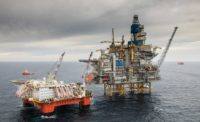California marine oil terminals are preparing to audit their facilities in compliance with a February upgrade to the state's building code. The process, which must be completed within two years, is expected to cost some $300 million to improve seismic resistance and modernize the terminals.
 |
| (Photo: Halcrow HPA) |
A recent incident at Port of Los Angeles Berth 239 highlighted the need for upgrading when forces induced by a passing vessel pulled a moored vessel off the wharf. Both vessels were about the same size, at 45,000 dead weight tonnage. The wharf was built in the 1940s to accommodate vessels of 5,000 to 10,000 DWT. The average age of California's marine oil terminals is over 50 years.
Under the Marine Oil Terminal Engineering and Maintenance Standards (MOTEMS), 34 "high risk" terminals must complete audits by Aug. 6, 2008. The audits and compliance measures are expected to average $5 million for each of the state's 60 terminals.
"Marine oil terminals intend to outline future projects in their plans timeline submitted to the California State Lands Commission (CSLC)," says Dennis Bolt, coordinator for Western States Petroleum Association. "Any findings may require significant world-class engineering efforts."
The Oakland, Calif., office of U.K.-based marine engineering firm Halcrow HPA Inc. is gearing up for the new rule. "We have in-house geotechnical engineers, but they're located outside of California. So we typically team with local geotechs who know the area or know the facility," says Gayle Johnson, Halcrow vice president.
 |
| Taking Measures. Marine oil terminals require seismic and functional modernization under new regulation. (Photo: CondcoPhillips) |
CSLC expects marine oil terminals on average to spend about $5 million to comply with the regulations. Larger facilities, such as Tesoro Oil Corp.'s Golden Eagle Refinery in Martinez and ConocoPhillips Co.'s San Francisco refinery, will each spend between $15 million and $20 million on inspections and repairs to strengthen the facilities to comply with the seismic criteria, upgrade manifolds, install uploading arms and gangway towers, and more, estimates Ted Trenkwalder, structural engineer for engineering firm Ben C. Gerwick Inc., San Francisco.
After the 1994 Northridge earthquake, the state lands commission won a hazard mitigation grant from the Federal Emergency Management Agency. The California Building Commission adopted the standards last year. They provide criteria for inspections above and below the waterline, structural and seismic rehabilitation, mooring and berthing analyses, tsunami threats, structural performance, fire, and mechanical and electrical systems.
"The FEMA grant started the process, and the grant was to mitigate the possibility of major damage from the next earthquake," says Martin L. Eskijian, supervisor of the Engi- neering Branch of CSLC's Marine Facilities Division. "Earthquake vulnerability is only one facet of the problem. Others included the geriatric condition of the facilities and their general unwillingness to do anything to update, the �grandfathering' of much larger vessels calling at the terminals, compared to the original design, and any form of coherent inspection program."


